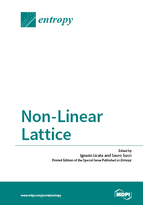Non-Linear Lattice
A special issue of Entropy (ISSN 1099-4300). This special issue belongs to the section "Statistical Physics".
Deadline for manuscript submissions: closed (30 November 2015) | Viewed by 72302
Special Issue Editors
2. School of Advanced International Studies on Applied Theoretical and Non Linear Methodologies of Physics, 70121 Bari, Italy
Interests: foundation of quantum theories; quantum cosmology; de sitter holographic models; dissipative quantum field theories; physics of emergence and organization; fisher information; sub- and super-Turing computation models
Special Issues, Collections and Topics in MDPI journals
Special Issue Information
Dear Colleague,
The development of mathematical techniques, combined with new possibilities of computational simulation, have greatly broadened the study of Non-Linear Lattices, a theme among the most refined and interdisciplinary of mathematical physics. This Special Issue mainly focuses on state-of-the-art advancements concerning the many facets of Non-Linear Lattices, from the theoretical ones to more applicable ones. The Non-Linear and discrete systems play a key role in all ranges of physical experience, from macrophenomena to condensed matter, up to some models of space discrete time.
Prof. Dr. Ignazio LicataDr. Sauro Succi
Guest Editors
Manuscript Submission Information
Manuscripts should be submitted online at www.mdpi.com by registering and logging in to this website. Once you are registered, click here to go to the submission form. Manuscripts can be submitted until the deadline. All submissions that pass pre-check are peer-reviewed. Accepted papers will be published continuously in the journal (as soon as accepted) and will be listed together on the special issue website. Research articles, review articles as well as short communications are invited. For planned papers, a title and short abstract (about 100 words) can be sent to the Editorial Office for announcement on this website.
Submitted manuscripts should not have been published previously, nor be under consideration for publication elsewhere (except conference proceedings papers). All manuscripts are thoroughly refereed through a single-blind peer-review process. A guide for authors and other relevant information for submission of manuscripts is available on the Instructions for Authors page. Entropy is an international peer-reviewed open access monthly journal published by MDPI.
Please visit the Instructions for Authors page before submitting a manuscript. The Article Processing Charge (APC) for publication in this open access journal is 2600 CHF (Swiss Francs). Submitted papers should be well formatted and use good English. Authors may use MDPI's English editing service prior to publication or during author revisions.
Keywords
- Plastic Deformations in Crystals
- Sin-Gordon Equations
- Fermi-Pasta-Ulam Problem
- Toda Lattice
- Boltzmann Lattice
- nonlinear waves and solitons
- Ergodicity and integrability problems
- Small Molecules with non linear local modes
- Protein Models
- DNA Models
- Neuronal Lattices Models
- Computational Issues
- Cellular Automata
- Historical Aspects in Non Linear Science
- Lattice gas
- Lattice Boltzmann
- Lattice gravity
- Quantum field theory
- Ultracold lattice fluids








